Along with other Mexican states Sonora constantly needed funds to maintain its finances, and invariably turned to contributions from wealthy merchants or hacendados. Authorities levied taxes on businesses and ‘requested’ special loans from their owners. The state kept a running account of the unpaid balance owed to hacendados and merchants under the heading deuda flotante (floating debt).
In 1853 the United States consul in Guaymas Juan Robinson, the owner of a large import-export house, reported that he had ‘lent’ more than 18,000 dollars to the state government{footnote}SD papers, reports of American Consuls, Record Group 59, vol 1-5 1832-1896, microcopy 284, reel 1{/footnote}. Robinson and others never actually anticipated repayment, although they did expect special treatment when requesting trade concessions or the acquisition of land from local officials.
Again, like other states, the inhabitants of Sonora were subjected to forced loans. These included:
On 19 August 1861 Colonel Antonio Esteves, in support of the Plan de Tacubaya, crossed the border from Sinaloa with two hundred men and seized Alamos. He made forced loans of $30,000 and recruited supporters among the influential conservative and clerical elements, including José María Tranquilino Almada and his brothers, Toribio and Vicente, who were given the rank of captain in Esteves' forces. The rebels also recruited soldiers among the Yaqui and and Mayo tribes, and marched into the interior but at Hermosillo, on 23 October, they were met and routed by Ignacio Pesqueira{footnote}Vicente Almada was killed in the battle, and Esteves and Toribio Almada fled to Chihuahua. Pesqueira continued on to Alamos, ordering his cavalry to scour the countryside for rebels. By 24 November the leaders had been hunted down, captured, and delivered to him. Pesqueira showed an unexpected lack of mercy which shocked even his closest friends when he executed Toribio Almada{/footnote}.
0n 6 October 1861 an insurrection broke out in Guaymas but was quickly suppressed. The government ordered a forced loan of $50,000 to be collected from foreigners as well as Mexicans. The U.S. consul protested, but five foreigners were compelled to pay and the near prospect of a man of war visiting the port was all that saved the rest from seizure of their goods{footnote}SD papers, reports of American Consuls, Record Group 59, vol 1-5 1832-1896, microcopy 284, reel 1 report of consul, Guaymas, 13 October 1861{/footnote}.
Whether any of the documents that the state or insurgents issued as a consequence as these ‘loans’ could be considered paper currency is a moot point. For example, we know of one certificado (numbered 128) of the Gefatura de Hacienda de Sonora issued on 15 June 1875 in Guaymas, for a short-term voluntary loan (prestamos voluntarios de pronto reintegal) of $4,500 from Messrs. Sandoval y Büller to be repaid out of the revenues of the Hermosillo and Alamos mints but it is not obvious whether the document was negotiable{footnote}Information from Clyde Hubbard{/footnote}.
Again, like certain other states, Sonora had to amortize its copper coinage in the 1860s. It suspended minting in February 1863 and on 19 May established a commission under the title Banco de Amortización de la Moneda de Cobre which was to use a quarter of the receipts of the Guaymas customs for its purpose. This was found to be insufficient, and so on 19 June 1867 Governor Ignacio Pesqueira levied a forced loan of 45,000 pesos on the leading citizens of the state{footnote}La Estrella de Occidente, 28 June 1867{/footnote}, Sonora priding itself on the fact that whilst other states had to seek federal aid to amortise their coinage it was able to resolve the problem without outside assistance. The various lenders were given as receipts certificados issued by the Jefatura de Hacienda: one such certificado for $1,100 had not been repaid by 1899 and on 3 November of that year the holder was given government bonds for the same amount{footnote}certificado of Jefe de Hacienda de las Rentas Federales y del Estado dated 20 September 1867 in favour of Rafael Córdova (AGHES, no reference){/footnote}.
Another form of pseudo paper currency should be mentioned. On 27 June 1879 the Guaymas correspondent of El Siglo Diez y Nueve reported that the salaries that local councils paid their teachers were not very generous and not always paid in cash, but sometimes in chits (boletas) that the teachers sold at a discount{footnote}El Siglo Diez y Nueve, 11 July 1879{/footnote}.
On 10 December 1881 in another effort to raise finance Governor Cárlos R. Ortiz published a law (núm. 22) authorising the Executive to issue 400,000 pesos in Treasury notes or certificates of deposit, redeemable on sight and to the bearer (billetes del Tesoro del Estado ó certificados de depósito, expedidos por la Tesorería General del mismo, reembolsales á la vista y al portador). The notes were to be issued in series of 1, 5, 10, 20, 50 and 100 pesos and signed by the Governor, the Secretary of State (Secretario de Estado), the Treasurer General (Tesorero General) and the Treasury Cashier (Contador de la Tesorería). They were to be of voluntary acceptance except in state and local finance offices, where they were to be taken as cash and at par in payment of taxes. Sixteen of the decree’s twenty-one articles deal with the legal redress available for any holder whose note was not accepted and with the penalties for counterfeiting, a fact that must have inspired confidence{footnote}La Constitución, 20 December 1881{/footnote}.
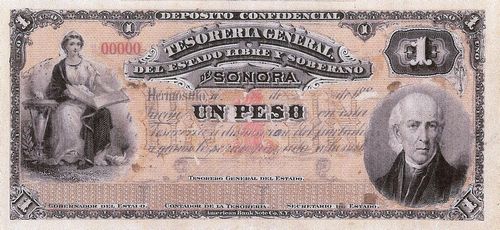
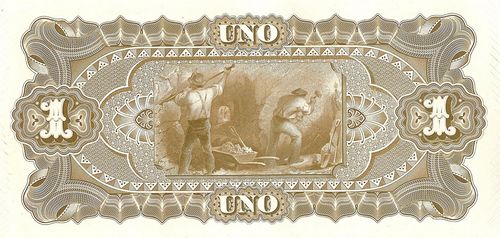
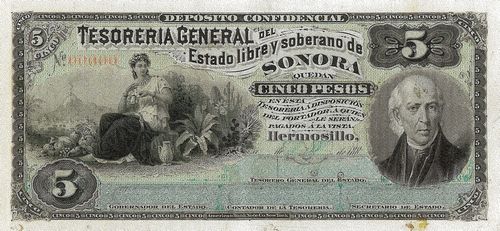
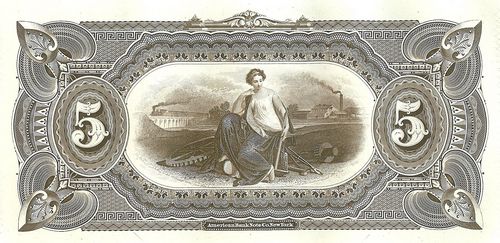

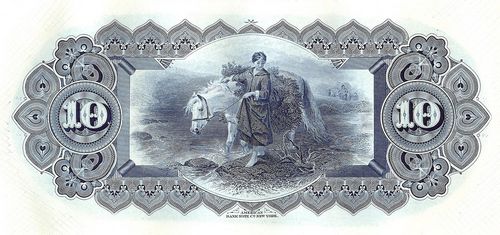
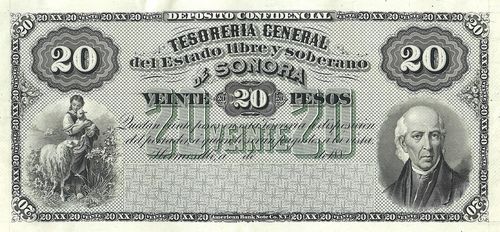
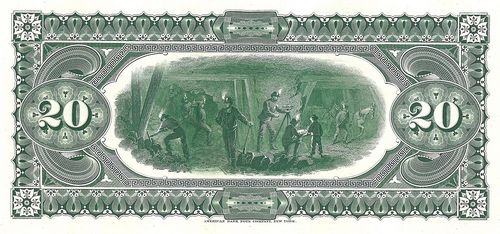
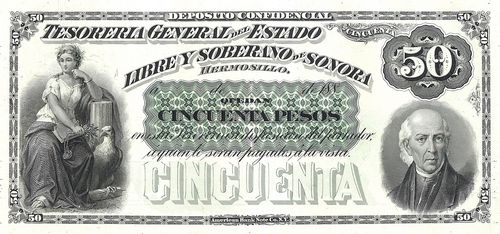

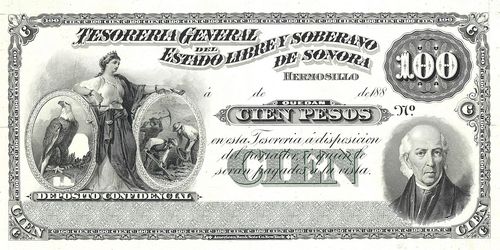
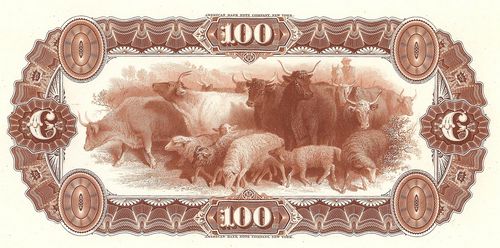
The American Bank Note Company received an order for $500,000 worth of bonds{footnote}The order was
$1 30,000 notes worth $30,000
$5 12,000 $60,000
$10 6,000 $60,000
$20 4,000 $80,000
$50 2,600 $130,000
$100 1,400 $140,000
56,000 $500,000{/footnote} and produced some proofs but they were ordered to stop work on 23 January 1882. The proofs are of all six denominations{footnote}As well as production material known are reverse proofs for the $1 and $5 and face and reverse proofs for the other four denominations{/footnote} and show that they were legally certificates of deposit, recording that a certain amount remained on deposit in the Treasury at the disposition of the bearer (Quedan ... pesos en esta Tesorería á disposción del portador á quien le seran pagados á la vista).
A series of ABNC models show alterations made and colours suggested during the process.
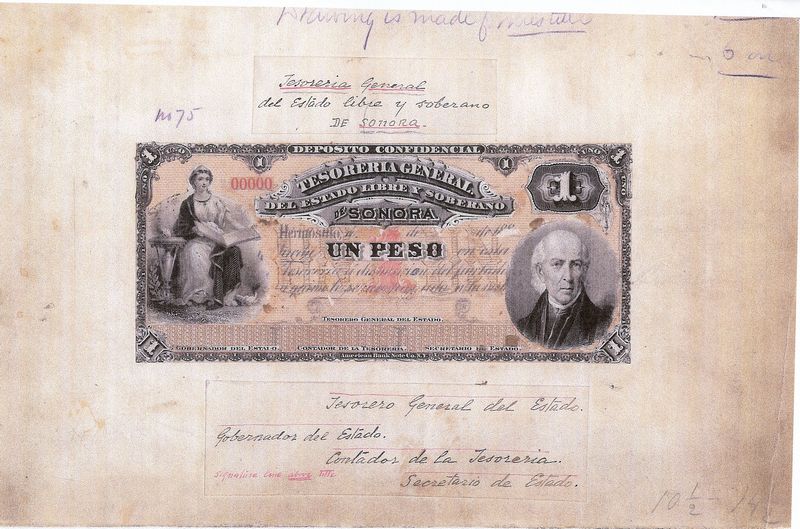
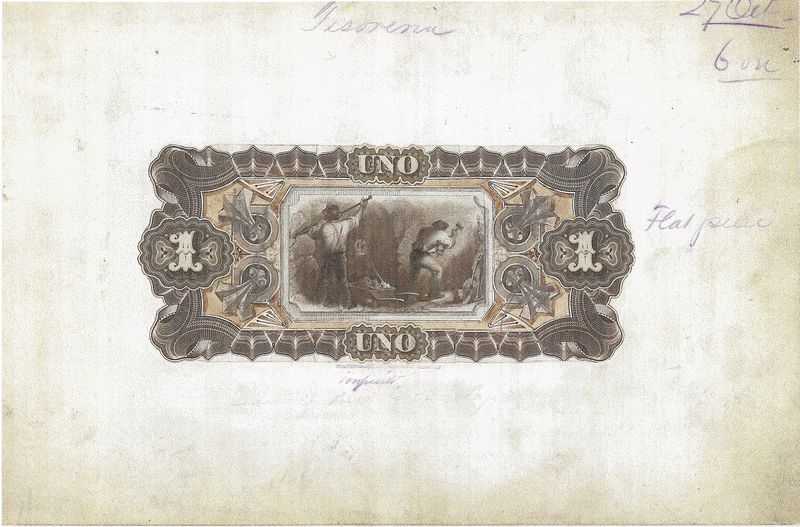
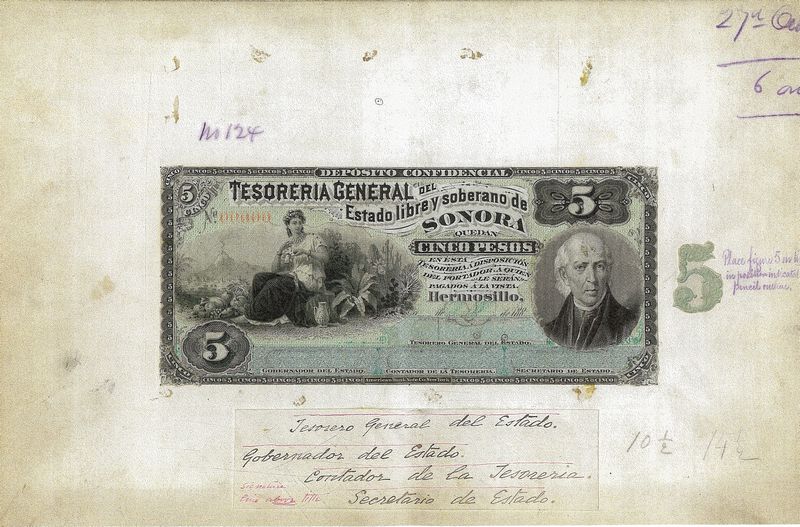
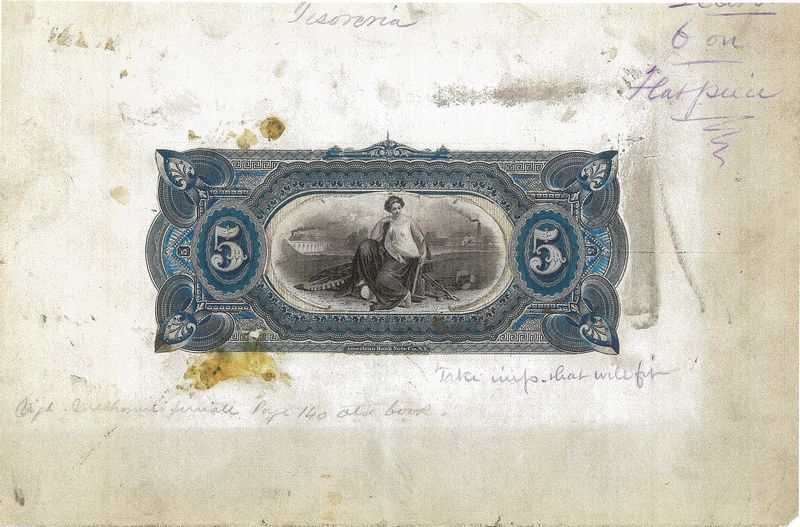
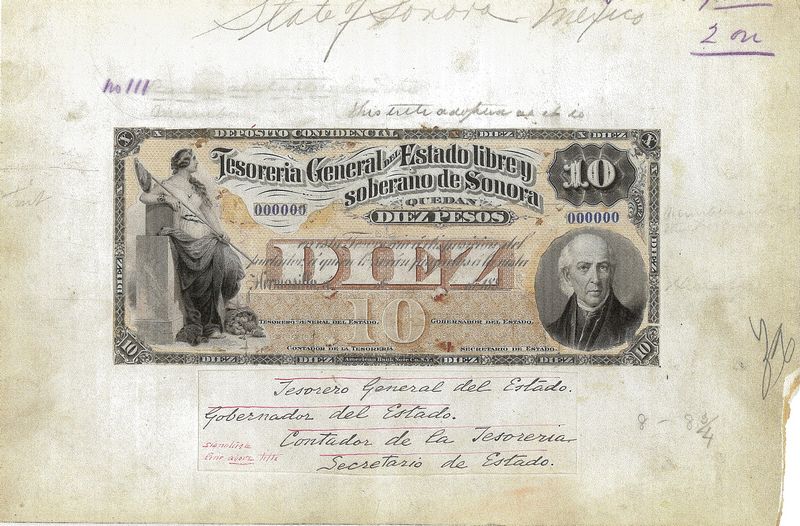
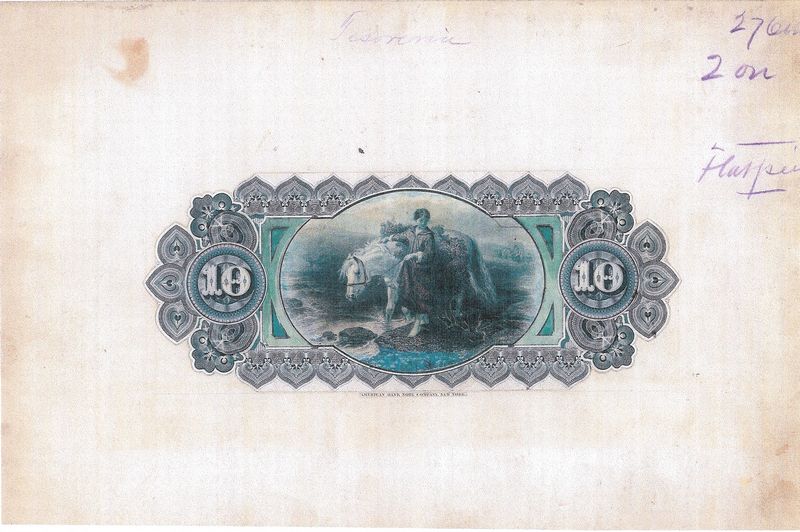
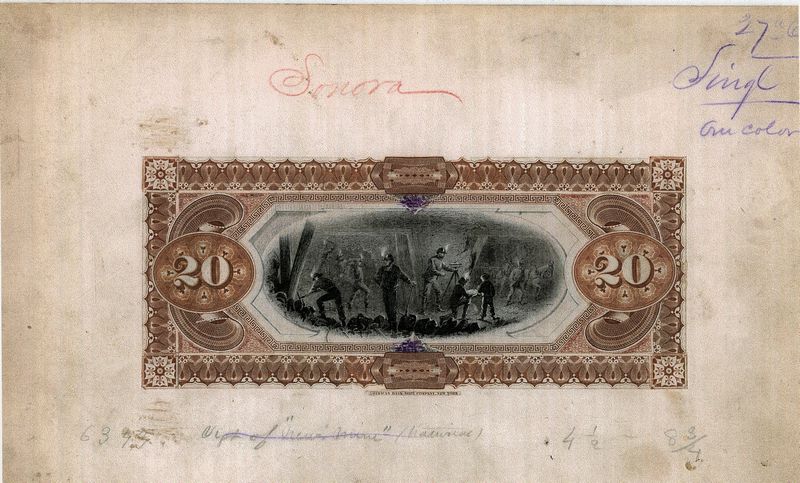
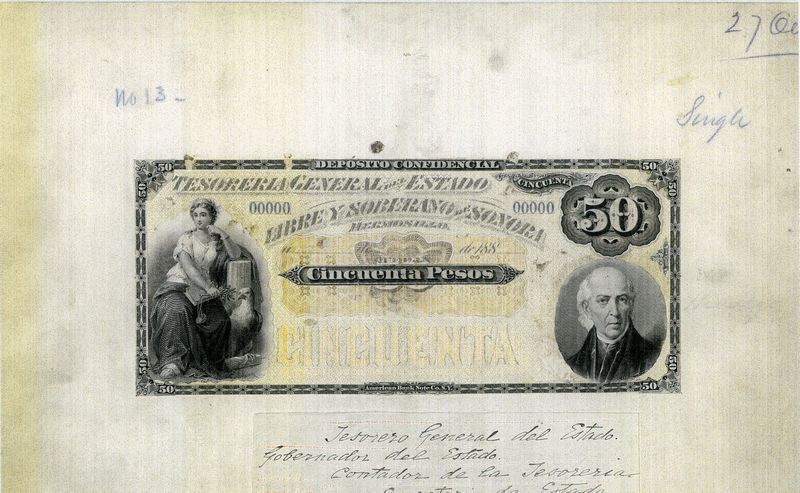
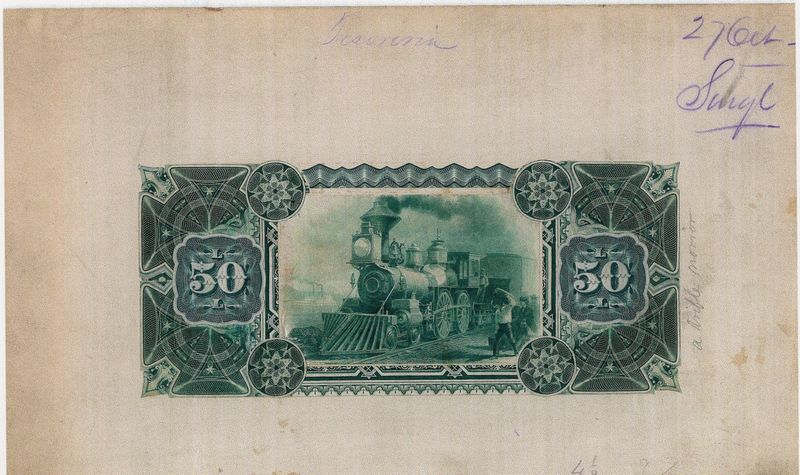

It would have been amusing if the ABNC had left in the ostrich, rather than replacing it with the Mexican eagle
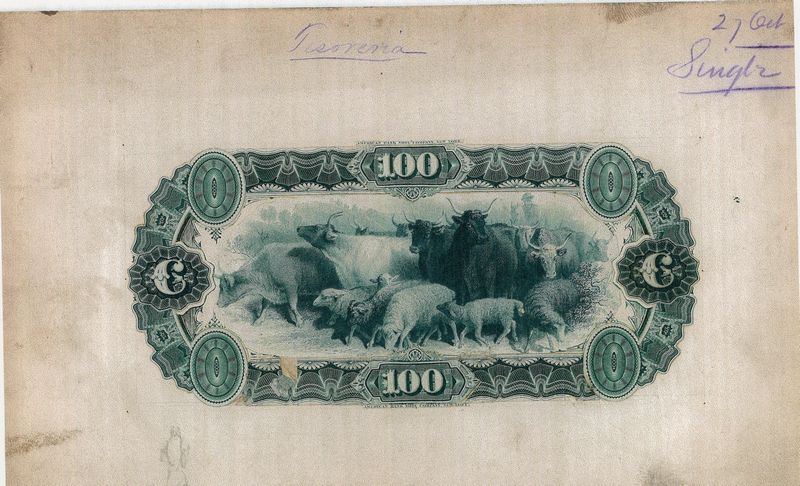
In the next twenty years there are a few references to other bonds. Thus, a bond number 26 for $200 was issued to Fernando S. Robles on 2 August 1889. Eleven days later it was endorsed to Carmelo Echeverría, who claimed $75 on it the next month, leaving $125 outstanding. On 2 January 1890 the bond was endorsed to Santiago Salcido, and finally cashed by his widow in 1921{footnote}AGHES, Fondo Oficialidad Mayor, tomo 3417, exp. 1{/footnote}.
On 28 March 1890 Manuel Mascareñas wrote to Rafael Ruiz asking him to buy $200 in state bonds (bonos del Estado) and send them to Victor Aguilar as payment for a patent to distill mescal{footnote}MM papers, copybook, vol. 4, p355, Mascareñas, Nogales to Ruiz, Hermosillo 28 March 1890{/footnote}. He had previously tried to buy them from Cirilo Ramírez{footnote}MM papers, copybook, vol. 4, p354, Mascareñas, Nogales to Victor Aguilar, Hermosillo 28 March 1890{/footnote}.
The bonds (Bonos del Estado) that covered the $1,100 owed to Rafael Córdova were numbered 26 (sic) to 31 and dated 3 November 1899{footnote}Córdova was owed the money as part of the $45,000 loan for the amortisacion of the copper coinage: he had received a certificate from the Jefe de Hacienda de las rentas Federales y del Estado, dated 20 September 1867, for $1,100 (AGHES, no reference){/footnote}. Again, in 1898 and 1899 the Banco de Sonora was offering to buy and sell bonds at what it claimed were the best rates possible{footnote}El Correo de Sonora, Guaymas, 10 October 1899{/footnote}.
Various bonds were issued to finance the Constitutionalist revolt.
We have record of various (forced) loans early in April 1913, including the $20,000 from Max Müller of the Banco de Sonora{footnote}The list includes: in March 1913 Max Müller’s $20,000; in April two assessments (derrames) in Hermosillo for $50,000.00 and $82,000.00; $12,000 in Ures in March and $13,500 in April; in April $5,000 from F. Monineau y Hermano; in September $28,000 from T. Robinson Bours Hermanos, of Alamos; also in September and in Alamos Miguel C. Urrea gave $5,000, Joaquín S. Urrea $2,000 and General Salvador Alvarado remitted $5,750 collected from various citizens (report of Oficial Primero, 13 June 1921). Finally there is $100 from Feliciano O[ ], of Caborca, om 17 March, 215.66 from Manuel Salcido, alsoof Caborca, on 18 August, and $1,000 from the Compañía Bancaria Mercantil of Cananea on 11 July{/footnote}.
In 1913, while Ignacio L. Pesqueira was governor, he decreed a war tax (contribución de guerra) on various haciendas. The Hacienda “Bacanuchi”, belonging to the estate of Elena Pesqueira de Caraway, was assessed at $6,000 and received a receipt from the Tesorero General, Carlos E. Randall. Once in the capital, Elena Pesqueira, through her cousin, Roberto V. Pesqueira, tried to get the central government to repay her, which she had all but achieved when Carranza fell. Adolfo de la Huerta, in his turn, was minded to pay, but Pesqueira had lost her receipt, and so asked for a certified copy{footnote}AGHES Fondo Oficialidad Mayor, tomo 3417, letter S. López Alvarado, Mexico City, to Secretario de Gobierno, 1 October 1921{/footnote}. On 9 November the Tesorero General replied that they had looked in the archives but could not find the files, since the Maytorenista government had taken the major part of the archives for 1913 through to 1915 with them{footnote}AGHES Fondo Oficialidad Mayor, tomo 3417, letter Secretario de Gobierno, to López Alvarado, 9 November 1921{/footnote}.
On 5 May 1913 at a meeting in Altar the Governor’s special commissioner Alberto B. Piña met with the major cattle-producers of the district. Piña explained that he was commissioned to purchase cattle, to be exported to the United States to obtain resources to pursue the revolution, and a committee was appointed to collect 3,000 head of cattle, to be delivered between 15 May and 20 July. The cattle were to be paid for by means of State bonds, with receipts given in the meantime{footnote}AGHES, Fondo Oficialía Mayor, tomo 2959{/footnote}.
On 14 August 1913 Maytorena decreed a forced subsidy on notorious enemies to the Constitutionalist cause to cover the costs of war{footnote}El Estado de Sonora, núm. 13, 16 August 1913{/footnote}. The decree established a commission (junta calificadora) to decide the amounts{footnote}Boletín Oficial, 14 August 1913{/footnote}. On 4 September Maytorena names Salvador Camacho, Lamberto Camou and Tomás Fragoso as the members of the commission. The commission assessed Alberto Mascareñas’ property at 316,000 pesos and imposed a monthly charge of 1,053 pesos, and Ramón Corral at over a million pesos, and a monthly charge of 5,000 pesos{footnote}AGHES, tomo 2970{/footnote}. However, this decree was derogated in December because it failed to produce positive results and did not have Carranza’s approval{footnote}On 26 December 1913 Felipe Riveros, the governor of Sinaloa, asked Maytorena to send him the rules and regulations establishing his forced loan (subsidio forzoso de Guerra) (AGHES, Fondo Oficialidad Mayor, tomo 2950 telegram Felipe Riveros, Culiacán, to Maytorena, Hermosillo, 26 December 1913, now missing in Archive so taken from colección Manuel González Ramírez 93/61) but Maytorena replied that the forced loan would be abolished within five days because it had failed to produce positive results and did not have Carranza’s approval. It was replaced by a surcharge (contribución adicional). However, he sent the relevant decree (AGHES, Fondo Oficialidad Mayor, tomo 2950 telegram Maytorena, Hermosillo to Felipe Riveros, Culiacán, 26 December 1913, now missing in Archive so taken from colección Manuel González Ramírez 93/63){/footnote} and was replaced by a new surcharge (contribución adicional).
On 10 April 1913 Interim Governor Ignacio L. Pesqueira authorised (decree núm. 4) the issue of a million pesos in interest-bearing bonds, to be sold to individuals, corporations or companies (though not to foreign governments or bodies{footnote}The Constitutionalists saw bonds (and paper currency) as a method by which Mexicans could contribute to the cost of the revolution. They did not want to be indebted to foreign interests.{/footnote}). The notes were to be in three denominations ($100, $500 and $1,000), signed by the Governor, Secretary of State and Treasurer General, payable to the bearer, readily transferable and redeemed in tranches selected by twice-yearly lots over a period of ten years{footnote}El Estado de Sonora, 11 April 1913{/footnote}. The bonds were printed by the Government Press (Imprenta de Gobierno) in thirty-one books{footnote}AGHES, Fondo Oficialidad Mayor, tomo 2965, letter Enrique Monkrendi, Director de la Imprenta del Gobierno, Hermosillo to José Rodriguez, Comisionado Visitador de la Tesorería General, Hermosillo, to Enrique Monkrendi, Director de la Imprenta del Gobierno, Hrmosillo, 23 October 1913. The text of such a bond was
Bono Número 120 - Serie B - $500·00 El Gobierno del Estado de Sonora pagará al portador la suma de QUINIENTOS PESOS, en los términos que previene el Decreto número 4 de fecha 10 de abril de 1913, expedido por el Ejécutivo del Estado de conformidad con las facultades que le confiere la ley Número 107 de 14 de diciembre de 1912 y la ley Número 117 de 25 de febrero de 1913 - Hermosillo - junio 18 de 1913 - El Gobernador del Estado - I. L. Pesqueira - El Tesorero Gral - A. Lewels - El Srio. General - Lorenzo Rozado
whilst on the reverse it carried references to the relevant decrees. (AGHES, Fondo Oficialidad Mayor, tomo 3492){/footnote}.
| no of books |
bonds in each |
series | from | to | total number |
total value |
|
| $100 | 20 | 100 | C | 1 | 2000 | 2,000 | $ 200,000 |
| $500 | 6 | 100 | B | 1 | 600 | 600 | 300,000 |
| $1,000 | 5 | 100 | A | 1 | 500 | 500 | 500,000 |
| $1,000,000 |
Robert Pesqueira, in Tucson, and Ignacio Bonillas, in Nogales, Sonora, had already been commissioned to find takers for the bonds{footnote}AGHES, Fondo Oficialidad Mayor, tomo 2965 letters I. L. Pesqueira, Hermosillo to R. Pesqueira, Tucson, and I. Bonilla, Nogales, 3 April 1913{/footnote}. On 16 April the government sent one book containing 100 $1,000 bonds (Series A, 1-100) to Pesqueira and another (Series A, 101-200) to Bonillas, both of whom were in Nogales{footnote}AGHES, Fondo Oficialidad Mayor, tomo 2965 letters I. L. Pesqueira, Hermosillo to R. Pesqueira, Nogales, and I. Bonilla, Nogales, 16 April 1913{/footnote}. Pesqueira later received another three books of $1,000 bonds and one of $500 bonds, so in total he received $450,000{footnote}AGHES, Fondo Oficialidad Mayor, tomo 2965{/footnote}.
A $500 bond issued to Jesús Ramos on 25 April was later exchanged on 29 August 1923 in accordance with circular núm. 29 of 29 June 1921{footnote}'Inasmuch as the records in the Government Offices concerning the bonds issued by the government of General Ignacio L. Pesqueira are incomplete and therefore the amount of these said bonds and other debts contracted in the same period is unknown, the State Executive has thought it expedient to issue a Circular so that people who are owed money by the State in the manner stated will present their titles to the General Secretariat of Government, in whose office a Register will be opened, within a period of four months from 15 July of the present year.' (Boletín Oficial, 12 July 1921){/footnote}.
Bonillas sold five $1,000 bonds to Ignacio Molina, of Cananea(?), in return for cheques drawn in the First National Bank of Douglas (and some safe-conducts){footnote}AGHES, Fondo Oficialidad Mayor, tomo 2965 telegram M. Bonillas, Prefecto of Cananea to I. L. Pesqueira, Hermosillo, 29 April 1913{/footnote}.
On 2 May a book of 100 $500 bonds (Serie B, 1-100) was sent to Cesáreo G. Soriano, Customs Administrator at Agua Prieta{footnote}AGHES, Fondo Oficialidad Mayor, tomo 2965, letter Secretario General, Hermosillo, to Soriano, Agua Prieta, 2 May 1913{/footnote}. On 6 May Luis. G. Hernández was also commissioned to sell bonds, both within Mexico and abroad{footnote}AGHES, Fondo Oficialidad Mayor, tomo 2965, letter Governor, Hermosillo, to Hernández, 6 May 1913{/footnote}. On 16 May fourteen $100 bonds (Serie A, 1-14) were sent to the Prefect of Magdalena to give to Abundio Elías of Santa Cruz (in payment for cattle){footnote}AGHES, Fondo Oficialidad Mayor, tomo 2965, letter Secretario General, Hermosillo to Prefecto, Magdalena, 16 May 1913{/footnote}.
On 21 May Silvestre Terrazas and Juan Neftali Amador were commissioned as (part of) the Junta Constitucionalista del Estado de Chihuahua to acquire the funds necessary for their cause, though as, unlike in Sonora and Coahuila, there was no Constitutionalist government in Chihuahua, they could not enact legal decrees. The next day they wrote from the Mills Building in El Paso to Ignacio L. Pesquiera, Governor of Sonora, asking for a loan of $10,000 or $20,000 (or rather 20 or 40 bonds of $500 each in the expectation that they would then place the bonds) and to Roberto Pesqueira, the Constitutionalist Confidential Agent in Washington, asking him to support their request{footnote}ST papers, part I , box 83{/footnote}.
On 24 May ten bonds of $500 (Serie B, 101-110) were issued in Nogales{footnote} B101-102 to José Marrarger for goods received during the 1910 revolution, B103-104 to Cónsul Chrayar (alternative Anaya (AGHES, Fondo Oficialidad Mayor, tomo 3729 report of Ricardo Diaz, Contador Mayor de Glosa, 27 September 1924)), B105 to Ramón Salazar (in payment for cattle), and B106-110 to Donnadieu Hermanos (also for cattle) (AGHES, Fondo Oficialidad Mayor, tomo 2965, report of José Rodriguez, C. V. de la Tesorería General, Hermosillo, 15 October 1913). Two of these were redeemed by the Governor on 16 April 1925 (AGHES, Fondo Oficialidad Mayor, tomo 3729, Governor to Tesorero General, 5 November 1925) but the others were refused by the State Congress on 5 November 1925 because of the critical state of Sonora’s finances (AGHES, Fondo Oficialidad Mayor, tomo 3729, Acuerdo of state congress, 5 November 1925).{/footnote}. In late May Bonilla arranged with Carlos Harman Jury to buy a printing press{footnote}the press was being used to print newspapers such as Justicia, critical of the regime, so this was an attempt to stamp down on the opposition (AGHE, Fondo Oficialidad Mayor, tomo 2993){/footnote} and $4,000 in bonds (B111-118) were issued to Francisco M. Hernández as the price{footnote}AGHES, Fondo Oficialidad Mayor, tomo 2965, telegram I. L. Pesqueira, Hermosllo, to I. Bonillas, Cananea, 23 May 1913. Jury asked for the bonds to be made out to him, rather than Hernández (AGHES, Fondo Oficialidad Mayor, tomo 2965, telegram Jury, Cananea, to Governor, Hermosillo, 30 May 1913) but the bonds (B111-118) were issued to Hernández on 30 May. Bonds B111-115 were recorded as issued to F. M. Fernandez (sic) in Cananea for a press: bonds B116-118 are recorded as to an unknown recipient but would have been Hernández (AGHES, Fondo Oficialidad Mayor, tomo 2965, report of José Rodriguez, C. V. de la Tesorería General, Hermosillo, 15 October 1913){/footnote}.
On 27 May Alfredo Durazo of Oputo took $3,000 in bonds{footnote}AGHES, Fondo Oficialidad Mayor, tomo 2965, telegram Plutarco E. Calles, Agua Prieta, to Governor, Hermosillo, 27 May 1913{/footnote}.
On 10 June A. C. Villaseñor, Prefecto of the Distrito of Magdalena, reported from Nogales that $3,000 in bonds that the governor had left had been used to pay the accounts of Ramón Vázquez ($187.50) and Escalada Bros. ($2,812.50){footnote}AGHES, Fondo Oficialidad Mayor, tomo 2965 letter Lewels, Hermosillo, to Secretario General, 4 June 1913{/footnote}.
On 16 June Roberto Pesqueira, from Eagle Pass, asked Angel J. Lagarda to send him $100,000 in bonds{footnote}AGHES, Fondo Oficialidad Mayor, tomo 2965 Lagarda, Agua Prieta, to Governor, Hermosillo, 16 June 1913{/footnote}, presumably because he thought that he had buyers. Ignacio Pesqueira agreed that Soriano should send them, as he had that amount{footnote}AGHES, Fondo Oficialidad Mayor, tomo 2965 Governor, Hermosillo, to Soriano, Agua Prieta, 17 June 1913{/footnote} and Soriano sent a book of 87 bonds, Serie C, 14-100{footnote}AGHES, Fondo Oficialidad Mayor, tomo 2965 Lagarda, Agua Prieta, to Governor, Hermosillo, 19 June 1913{/footnote}.
On 18 June two $500 bonds (B119 and B120) were issued in Hermosillo to an unknown recipient{footnote}AGHES, Fondo Oficialidad Mayor, tomo 2965, report of José Rodriguez, C. V. de la Tesorería General, Hermosillo, 15 October 1913{/footnote} so the booklet must have been returned from the north. On 30 June another 38 $500 bonds were issued in Hermosillo{footnote}Bonds B121-150 to Miguel Latre y Hermano, B151-156 no details recorded, B157 and B158 to B. S. Pelzer for purchases of beans (AGHES, Fondo Oficialidad Mayor, tomo 2965, report of José Rodriguez, C. V. de la Tesorería General, Hermosillo, 15 October 1913). The last two bonds (and another for $100) were cashed by Pelzer on 8 October 1913 (AGHES, Fondo Oficialidad Mayor, tomo 2965, Tesorero General Randall, to Governor, Hermosillo, 8 October 1913).{/footnote}.
On 29 June Roberto Pesqueira reported to Governor Pesqueira from Agua Prieta that the Columna Villa had neither recourses nor provisions. He would send Lagarda to Cananea in the morning to raise funds with bonds from Molina and Rafael Elías. He thought they could raise $20,000 with ease{footnote}AGHES, Fondo Oficialidad Mayor, tomo 2950 telegram R. V. Pesqueira, Agua Prieta, to governor I. L. Pesqueira, Hermosillo, 29 June 1913, now missing in Archive so taken from colección Manuel González Ramírez 91/315{/footnote}. However, Pesqueira replied that Molina had already bought bonds and Elías had given cattle, goods and provisions, so he did not think they could raise that much, but was asking Prefecto Bonillas to give Lagarda as much help as possible{footnote}AGHES, Fondo Oficialidad Mayor, tomo 2950 telegram governor I. L. Pesqueira, Hermosillo to R. V. Pesqueira, Agua Prieta, 30 June 1913, now missing in Archive so taken from colección Manuel González Ramírez 91/316{/footnote}.
In Alamos Alfredo Murillo, the Jefe de Armas, was given a book of $500 bonds to offer to potential investors. On 4 August he reported assigning $12,000 to the Señores Urrea, who agreed to pay $1,000 a month, at the same time asking about the 10% discount mentioned in the original decree{footnote}AGHES, Fondo Oficialidad Mayor, tomo 2965 Murillo, Alamos, to Governor, Hermosillo, 4 August 1913{/footnote}. In response, Secretario Lorenzo Rosado asked for details of bonds in his possession{footnote}AGHES, Fondo Oficialidad Mayor, tomo 2965 Rosado, Hermosillo, to Murillo, Alamos, 6 August 1913. Maytorena has resumed the governorship two days earlier{/footnote}: Murillo replied that he had been given 100 $500 bonds and was placing fourteen, as well as the twenty-four that the Urrea offered to take{footnote}AGHES, Fondo Oficialidad Mayor, tomo 2965 Murillo, Alamos, to Rosado, Hermosillo, 6 August 1913{/footnote}. On 16 August José J. Obregón, Prefecto of Alamos, sent $8,100 which had been raised from the sale of bonds{footnote}out of a total remittance of $15,826.98 (AGHES, Fondo Oficialidad Mayor, tomo 2914 telegram José J. Obregón, Alamos to Maytorena, Hermosillo, 16 August 1913). On 22 August Alvaro Obregón reported that Mayor Fermin Carpio brought $15,000 from the sale of bonds, which Obregón wanted to be used for the expenses of war (AGHES, Fondo Oficialidad Mayor, tomo 2914 telegram Alvaro Obregón, Maytorena to Maytorena, Hermosillo, 22 August 1913) but he was probably referring to the same deposit{/footnote}. By 3 September José J. Obregón suggested that the wealthy of Alamos had been given enough time, and suggested that the bonds that the Jefe de Armas had be sent to Hermosillo{footnote}AGHES, Fondo Oficialidad Mayor, tomo 2965 telegram José J. Obregón, Alamos to Maytorena, Hermosillo, 3 September 1913{/footnote}. Maytorena replied by asking what bonds and what instructions the Jefe de Armas had{footnote}AGHES, Fondo Oficialidad Mayor, tomo 2965 telegram Maytorena, Hermosillo to José J. Obregón, Alamos, $ September 1913{/footnote}, and on being told, ratified the instructions whilst Oficial Mayor Sánchez Azcona wanted to know who had refused to take bonds{footnote}AGHES, Fondo Oficialidad Mayor, tomo 2965 telegram Sánchez Azcona, Hermosillo to Prefecto, Alamos, 5 September 1913{/footnote}. José Maria Quiron later complained that he had been forced to take $4,000 in bonds{footnote}Listed in AGHES, Fondo Oficialidad Mayor, tomo 2983 but actual complaint missing{/footnote}.
We have details of some of these Alamos bonds. Bond B 501 was placed with Quong Gun Lug & Cia, Sucs{footnote}but lost when the Villistas later sacked the town (AGHES, Fondo Oficialidad Mayor, tomo 3417, letter Quong Gun Lung & Cia, Sucs., Alamos, to Governor, 13 July 1921{/footnote}. Bonds B 502-509 and B 516 were given to Gérman Bley{footnote}These were exchanged for 45 vales of $100 on 16 June 1920, to used in the payment of 50% of taxes, 20 made out to Rosenda Gomez Lamadrid, 10 to Germán Bley and 15 to Merceria de la Paz. S.A. (AGHES, Fondo Oficialidad Mayor, tomo 3417 letter Felipe A. Seldner (Bley’s representative), Hermosillo, 16 June 1920: letter Governor to Tesorero General, 16 June 1920){/footnote}. Bond B 510 was issued on 5 August to Filiberto Acosta{footnote}and accepted in payment in 1925 (AGHES, Fondo Oficialidad Mayor, tomo 3729, Governor to Tesorero General, 11 February 1925){/footnote}. Bonds B 514 and 515 dated 6 August and 7 August respectively were exchanged for 1923 Bonds on 30 August 1923 by Sra. Trinidad A. Viuda de Almada{footnote}{/footnote}. On 13 August Bond B 518 was issued to Pedros S. Salazar{footnote}AGHES, Fondo Oficialidad Mayor, tomo 3417, letter Francisca Otero V. de Salazar, Alamos to Governor, 17 June 1921{/footnote}. Bond B 542 was issued to Carlos Hoffman of Alamos on 30 September{footnote}AGHES, Fondo Oficialidad Mayor, tomo 3729 exp. 8{/footnote}.
On 27 August Maytorena asked Roberto Pesqueira for details of the bonds he had placed{footnote}AGHES, Fondo Oficialidad Mayor, tomo 2965 telegram Maytorena, Hermosillo to Pesqueira, Los Angeles, 27 August 1913{/footnote} and Pesqueira replied that there were $400,000 in Douglas and Washington and that he was still trying to place them but was only being offered 75% (of the face value){footnote}AGHES, Fondo Oficialidad Mayor, tomo 2965 telegram Pesqueira, Los Angeles, to Maytorena, Hermosillo, 29 August 1913{/footnote}.
On 15 October the following were reported as being in the Tesorería General{footnote}AGHES, Fondo Oficialidad Mayor, tomo 2965, report of José Rodriguez, C. V. de la Tesorería General, Hermosillo, 15 October 1913{/footnote}, totally $299,500:
| Books | Bonds in each | Value | Series | from | to | Total value |
|---|---|---|---|---|---|---|
| 1 | 86 | $100 | C | 15 | 100 | 8,600 |
| 14 | 100 | 301 | 1700 | 140,000 | ||
| 1 | 99 | 1701 | 1756 | 9,900 | ||
| 1758 | 1800 | |||||
| 2 | 100 | 1801 | 2000 | 20,000 | ||
| 1 | 42 | $500 | B | 159 | 200 | 21,000 |
| 2 | 100 | 301 | 500 | 100,000 |
Series C 1757 was missed out by the printers.
On 24 October Tesorero General Randall pointed out to the Secretario de Estado that, as the date of the first drawing of lots was approaching, it as necessary to ascertain the correct information on the bonds issued and that they should ask the various agents for a detailed reckoning{footnote}AGHES, Fondo Oficialidad Mayor, tomo 2965, letter Randall, Hermosillo, to Secretario, Hrmosillo, 24 October 1913{/footnote}. The previous day his Visitador had written to the government printing press for details of what they had printed{footnote}AGHES, Fondo Oficialidad Mayor, tomo 2965, letter José Rodriguez, Comisionado Visitador de la Tesorería General, Hermosillo, to Enrique Monkrendi, Director de la Imprenta del Gobierno, Hermosillo, 23 October 1913{/footnote}. When the Visitador reported to the Tesorería General on 6 December 1913 he had been unable to account for $70,000 in bonds, viz.:
| Books | Bonds in each | Value | Series | from | to | Total value |
|---|---|---|---|---|---|---|
| 2 | 100 | $100 | C | 101 | 300 | 20,000 |
| 1 | 100 | $500 | B | 201 | 300 | 50,000 |
but it can be seen that these reappeared later.
Four books, totalling $169,500, were returned to the Tesoreria General on 3 April 1914{footnote}AGHES, Fondo Oficialidad Mayor, tomo 2983, letter Oficial Mayor to Tesorero General, 3 April 1914: tomo 3417, report, 13 June 1921. They were C 101-300 (200 of $100, or $20,000; D 201-299 (99 of $500, or $45,500, and A 401-500 (100 of $1,000, or $100,000).{/footnote}. Finally, on 13 April 1914 the following bonds remained unissued in the Tesorería General and were remitted to the Secretary of State for safe-keeping, a total of $514,400{footnote}AGHES, Fondo Oficialidad Mayor, tomo 2983{/footnote}:
| Books | Bonds in each | Value | Series | from | to | Total value |
|---|---|---|---|---|---|---|
| 1 | 85 | $100 | C | 16 | 100 | 8,500 |
| 16 | 100 | 101 | 1700 | 160,000 | ||
| 1 | 99 | 1701 | 1756 | 9,900 | ||
| 1758 | 1800 | |||||
| 2 | 100 | 1801 | 2000 | 20,000 | ||
| 1 | 92 | $500 | B | 9 | 100 | 46,000 |
| 1 | 41 | 159 | 200 | 20,500 | ||
| 1 | 99 | 201 | 299 | 49,500 | ||
| 2 | 100 | 301 | 500 | 100,000 | ||
| 1 | 100 | $1000 | A | 401 | 500 | 100,000 |
When Luis Sotomayor handed over responsibility for the Tesorería General to Jesús Ramos in December 1914 he listed firstly 243 bonds, totaling $299,400, in agreement with the 15 October report above, except that Bond A 15 for $100 had been issued to Bernardo S. Pelzer; and secondly another 529 bonds, totaling $234,500 (100 $1000 bonds A 401-500, totaling $100,000: 229 $500 bonds B 9-100, B 201 – 299, B 563 – 600, totaling $114,500, and 200 $100 bonds C 101 – 300, totaling $20,000). This second tranche had been received after the October visit, but Sotomayor could not recall when except that bonds B 563 – 600 had been recently sent by the Administración de Rentas in Alamos{footnote}AGHES, Fondo Oficialidad Mayor, tomo 2991, handover folder, 15 – 22 December 1914{/footnote}.
In June 1921 the state Congress asked for the government to check the records in the archives and produce a report on the bonds of the Pesquiera era, but that contained errors{footnote}AGHES, Fondo Oficialidad Mayor, tomo 3417, report, 13 June 1921: tomo 3729, {/footnote}. As the records were incomplete the government also asked people to present any claims. Various people submitted 1913 bonds, so we have a few more details.
So we can surmise that the bonds put into circulation were drawn from:
| Books | Bonds in each | Value | Series | from | to | Total value | Given to | Recipient |
|---|---|---|---|---|---|---|---|---|
| 1 | 15 | $100 | C | 1 | 14 | 1,400 | Villaseñor | Abundio Elías |
| 15 | 100 | B. S. Pelzer(?) | ||||||
| 1 | 8 | $500 | B | 1 | 8 | 4,000 | Soriano | |
| 1 | 58 | 101 | 102 | 1,000 | José Marrarger | |||
| 103 | 104 | 1,000 | Cónsul Anaya | |||||
| 105 | 500 | Villaseñor | Ramón Salazar | |||||
| 106 | 110 | 2,500 | Donnadieu Hermanos | |||||
| 111 | 118 | 4,000 | Francisco M. Hernández | |||||
| 119 | 120 | 1,000 | ||||||
| 121 | 156 | 18,000 | Miguel Latre y Hermano{footnote}alternative Miguel Latz y Hermanos{/footnote} | |||||
| 157 | 158 | 1,000 | B. S. Pelzer | |||||
| 1 | 1 | 300 | 500 | Luis S. Hernández{footnote}entrusted unsigned to Hernández (AGHES, Fondo Oficialidad Mayor, tomo 2983){/footnote} | ||||
| 1 | 100 | 501 | 500 | Murillo | Quong Gun Lung & Cia, Sucs. | |||
| 502 | 509 | 4,000 | Germán Bley | |||||
| 510 | 500 | Filiberto Acosta | ||||||
| 511 | 513 | 1,500 | ||||||
| 514 | 515 | 1,000 | [ ] Almada | |||||
| 516 | 500 | Germán Bley | ||||||
| 517 | 500 | |||||||
| 518 | 500 | Pedro S. Salazar | ||||||
| 519 | 541 | 11,500 | ||||||
| 542 | 500 | Carlos Hoffman | ||||||
| 543 | 600 | 29,000 | ||||||
| 4 | 100 | $1000 | A | 1 | 100 | 100,000 | Pesqueira | |
| 101 | 200 | 100,000 | Bonillas | |||||
| 201 | 400 | 200,000 |
As these bonds were later redeemed or cancelled none are known to have survived.
Gonzalez Rodriguez y Cia. received certificado núm. 16, dated 17 February 1914, for $17,145.51 for goods delivered from 17 May to 28 June 1913 and Mercería de la Paz, S.A. five certificados, núm. 17-21, dated 6 March 1914, for $9,506.94 for good delivered in March to July 1913{footnote}AGHES, Fondo Oficialidad Mayor, tomo 3417, notes R. Aviles, Contador de La Tesorería General, 17 June 1921{/footnote}.
It seemed that there were very few takers for the bonds and so in January 1914 it was decided that they should be used to pay people who held créditos for goods requisitioned during the last ten months’ fighting. Such people were given a month to present their claims to the Tesorería General{footnote}El Estado de Sonora, 20 January 1914. The period was later extended to two months for locals and four months for others (foráneos) (El Estado de Sonora, 3 February 1914){/footnote}.
On 8 February 1914 Tesorero General Sotomayor wrote to Maytorena to say that he was receiving enquiries from people involved in the derrame of cattle (see above) and to ask whether he could issue bonds, as per the contracts. He thought that they should ask the Prefects of the Districts of Altar and Magdalena (based in Nogales) for details{footnote}AGHES, Fondo Oficialía Mayor, tomo 2985, letter Sotomayor to Maytorena, 8 February 1914{/footnote}. Maytorena agreed{footnote}AGHES, Fondo Oficialía Mayor, tomo 2985, letter Maytorena to Sotomayor, 9 February 1914{/footnote}. Villaseñor confirmed that he had given bonds to Donnadieu Hermanos, Ramón Salazar and Abundio Elias{footnote} AGHES, Fondo Oficialía Mayor, tomo 2985, letter Villaseñor, Nogales, to Secretario de Estado. Hermosilo, 13 February 1914. Florencio Pierson did not receive any bond for the 43 cattle, valued at $530, that he gave{/footnote}.
However, due to poor book-keeping, it was found impossible to establish how many and to whom the bonds had been sold and so in order to regularise matters and proceed with the holding of the first draw on 7 March 1914 Governor Maytorena (decree núm. 42) authorised a new printing. These were to be similar to the first issue but would carry a reference to this later decree on the reverse. All the bonds of the first issue were to be exchanged for bonds of the second issue whilst those still in the Tesorería were to be cancelled with a reference to the present decree signed by the Treasurer General{footnote}Alcance to El Estado de Sonora, 7 March 1914{/footnote}.
| Books | Bonds in each | Value | Series | Number range |
|---|---|---|---|---|
| 20 | 100 | $100 | C | 1-2000 |
| 6 | 100 | $500 | B | 1-600 |
| 5 | 100 | $1000 | A | 1-500 |
These books were printed and delivered to the Tesorería in April{footnote}AGHES, Fondo Oficialidad Mayor, tomo 2983, letter Oficial Primero to Tesorero General, 4 April 1914{/footnote}. When Luis Sotomayor handed over responsibility for the Tesorería General to Jesús Ramos in December 1914 he listed the following bonds as in the Tesorería unissued:
| Books | Bonds in each | Value | Series | from | to | Total value |
|---|---|---|---|---|---|---|
| 20 | 100 | $100 | C | 1 | 2000 | 200,000 |
| 1 | 64 | $500 | B | 37 | 100 | 32,000 |
| 5 | 100 | 101 | 600 | 250,000 | ||
| 1 | 90 | $1000 | A | 11 | 100 | 90,000 |
| 4 | 100 | 101 | 500 | 400,000 |
and Sotomayor recorded that the 36 $500 bonds (B 1-36) had been issued to Miguel Latz y Hermanos of Magdalena as replacements for bonds B 121 – 156 of the old issue and the ten $1,000 bonds (C 1-10) had been issued to the Moctezuma Copper Company, again in exchange for bonds of the earlier issue{footnote}AGHES, Fondo Oficialidad Mayor, tomo 2991, handover folder, 15 – 22 December 1914{/footnote}.
Meanwhile, in order not to interrupt the process of meeting creditors’ claims, the Tesorería General was instructed to issue certificates or documentary proofs (certificados ó constancias) that would be exchangeable for bonds at a later date{footnote}Alcance to El Estado de Sonora, 7 March 1914{/footnote}.
One such certificado for $10,713.08 was issued to Quang Chung Lung on 6 April, endorsed to Luis Wolf of Guaymas on 29 September 1914, and later to Carlos Fong of Fong Hong y Cia, Sucs., Cocorit. The certificado mentioned that it would be paid in state bonds (Bonos del Estado). On 17 November 1921 Carlos Fong was asking for payment but was told to contact the central government{footnote}AGHES, Fondo Oficialidad Mayor, tomo 3417 letter Fong Hong y Cía, Sucs., Cócorit, to Governor 17 November 1921; letter Secretario to Carlos Fong, Cócorit, 19 November 1921. The text was “Al margen un sello que dice: - República Mexicana. – TESORERIA GENERAL DEL ESTADO DE SONORA. – HERMOSILLO. – Núm. 39 – EL TESORERO GENERAL DEL ESTADO que subscribe, hace constar que el Sr. QUING CHUNG LUNG, he presentado y dejado en poder de esta Tesorería dos facturas que amparan mercancías que ministró al Estado, para sus atenciones de guerra, durante el periodo comprendido del 1ro. de Febrero al 31 de Diciembre de 1913, las cuales le fueron admitidas de conformidad reconociéndosele el crédito cuyo importe total es de: $10,713.88 DIEZ MIL SETECIENTOS TRECE PESOS OCHENTA Y OCHO CENTAVOS, que le será pagado con BONOS DEL ESTADO, que se le expedirán una vez que sea acordada la fecha que el caso requiere.
Y para constancia y debida seguridad al interesado, expido el presente documento que será canjeado por los BONOS de que se hace mérito. – Hermosillo, Abril 6 de 1914. – El Tesorero General, Interino. – L.SOTOMAYOR. – (Rúbrica.) esta Constancia es transferible por medio de endoso entre dos testigos. – Páguese a la orden del Sr. Luis Wolf, Valor entendido. – Guaymas, Septiembre 29 de 1914. – QUONG CHONG LUNG. – Testigo EDUARDO GUERRERO. – Testigo T. Marcor – (Rúbricas). – Paguese a la orden de los Sres. Fong Hong y Cía.,Sucs. Cocorit, Valor entendido. – LUIS WOLF. (Rúbrica).”{/footnote}.
Finally, in July 1915 Maytorena decreed (núm. 76) an issue of five million pesos in $100 bonds to guarantee his paper money{footnote}El Estado de Sonora, 13 July 1915{/footnote}. The bonds were to be payable to the bearer, easily transferable and signed by the Tesorero General and the Director of the Agencia Financiera. However, by this time Maytorena’s cause was dying and it is reasonable to assume, given the difficulties he had encountered at the height of his powers, that nothing came of this decree.
On 29 June 1921 circular 29 asked people who had bonds or other claims from this period to present them within four months from 15 July to a registry in the Secretaría General{footnote}Boletín Oficial, 12 July 1921{/footnote}. At the same time people were asking for repayment of other documents, for example, bonds of the Junta Hacendaría de Guerra (see below) or other receipts. The government appears to have been extremely reluctant to honour these debts but generally perseverance paid off.
On 11 March 1914 Carranza, whilst in Agua Prieta, by his decree núm. 23, created a Junta Hacendaría de Guerra, composed of Francisco S. Elías, Angel J. Lagarda and Alejandro C. Villaseñor, to raise loans (voluntary or otherwise) for the Constitutionalist cause. We know of one bond, núm. 49, for $400, signed by Lagarda y J. M. Lizarraga{footnote}AGHES, Fondo Oficialidad Mayor, tomo 3417, letter Florencio Frisby, Cumpas, to Governor, 29 August 1921 asking for payment. After examination the bond was returned (AGHES, Fondo Oficialidad Mayor, tomo 3417, letter Secretario de Gobierno to Florencio Frisby, Cumpas, 8 October 1921{/footnote}: Angela G. Vda. de Pico, of Arizpe, ended up with $1,450 in such bonds{footnote}AGHES, Fondo Oficialidad Mayor, tomo 3417, Secretario de Gobierno to Angel G. Vda. de Pico, Arizpe, 5 November 1921{/footnote}, whilst Francisco F. Villa, of Cumpas, has bond num. 12 for $275 U.S. dollars{footnote}AGHES, Fondo Oficialidad Mayor, tomo 3417, Francisco F. Villa, Cumpas, to Secretario de Gobierno, 18 October 1921. On 13 January 1921 the state agreed to pay Ignacio G. Soto $2,000 for four bonds, núm. 1 to 4, that he had (AGHES, Fondo Oficialidad Mayor, tomo 3417, letter Secretario de Gobierno to Diputado Ignacio G. Soto, 13 Jan 1921) These were stated to be in ORO NACIONAL and so were possibly Junta Hacendaría de Guerra bonds.{/footnote} .
Donaciano Mungaro of Cumpas made a voluntary loan of $125 to the Junta and received only an acknowledgement (oficio) as there was no time to issue a receipt{footnote}AGHES, Fondo Oficialidad Mayor, tomo 3417 letter Donaciano Mungaro, Cumpas, to Governor, 14 December 1921{/footnote}. Servando Guerra received a certificado (elsewhere bono) for $400{footnote}AGHES, Fondo Oficialidad Mayor, tomo 3417 letter Angela G. Vda, de Guerra, to Governor, 5 August 1921{/footnote}.
On 28 May 1921 circular 24 said that the Junta's bonds could be used in payment of taxes up to the year 1920. Some claimants were redirected to the central Secretaría de Hacienda y Crédito Público in Mexico City for any compensation{footnote}For example, AGHES, Fondo Oficialidad Mayor, tomo 3417 letter Gobernador Interino to Adolfo de la Huerta, Secretario de Hacienda y Crédito Público, 10 August 1921{/footnote}.
By 1921 there was not enough money to pay the salaries of public employees and so Interim Governor Francisco S. Elías decided to pay only 90% of most such salaries with the remaining 10% being covered by bonds (Bonos por Empleados Públicos). The bonds were to bear interest, would be payable to the bearer and easily transferable, and redeemed once the state’s finances had improved. They were to be signed by the Governor, Secretary of State and Treasurer General{footnote}Boletín Oficial, 18 August 1921{/footnote}.
In 1923 the then Governor, Adolfo de la Huerta, authorised (decree núm. 90) an issue of bonds to liquidate the debts that had arisen from outstanding wages, the 1921 bonds, and the 67% of teachers’ salaries withheld in the previous year. The issue was to be of $350,000 in bonds of three values between ten and one hundred pesos{footnote}Alcance to Boletín Oficial, 11 May 1923{/footnote}. Originally there were 500 Series A $100 bonds numbered 1 to 500; 2,000 Series B $50 bonds numbered 501 to 2500 and 20,000 Series C $10 bonds numbered 2501 to 22500 but as the Series B were found to be in least demand and the Series A were used up 10,000 of the $10 bonds (numbered 12501 to 22500) were cancelled and another 1,000 Series D $100 bonds (numbered 12501 to 13500) issued{footnote}The changes were authorised by a regulation on 27 June 1923 (AGHES, Fondo Oficialidad Mayor, tomo 3560){/footnote}.
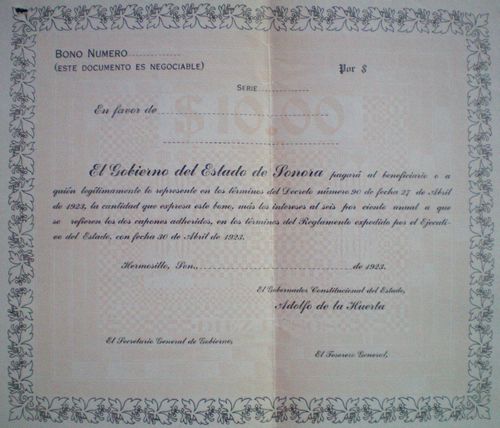
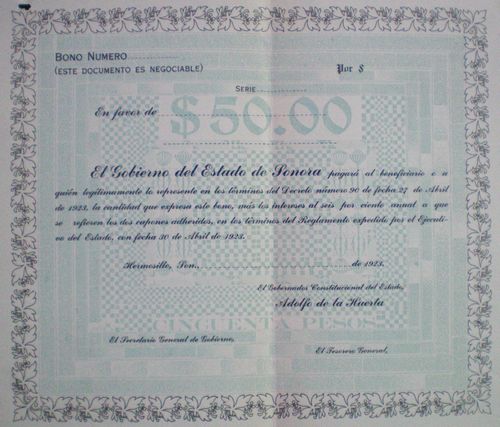
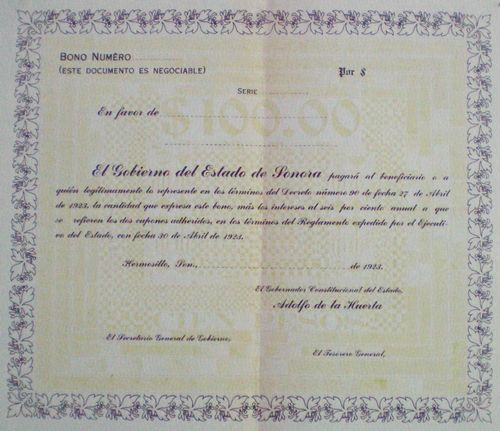
| Series | to | from | total number |
total value |
||
| $10 | C | 2501 | 12500 | 10,000 | $ 100,000 | brown |
| $50 | B | 501 | 2500 | 2,000 | 100,000 | blue |
| $100 | A | 1 | 500 | 500 | 50,000 | yellow-green |
| D | 12501 | 13500 | 1,000 | 100,000 | yellow-green | |
| $ 350,000 |
By 25 August 1923 $284,770 worth had been issued{footnote}Amounts of less than $10 were covered by certificados. By 11 July 1923 the following bonds had been issued:
Series C $10 2501-2880, 2882-3606, 3608-3991, 2892bis, 3437bis $7,670
Series B $50 501-2191 $84,500
Series A $100 1-494, 194bis, 236bis $49,600
Series D $100 12501-12900 $40,000
$181,770
but others followed, e.g. $10 C 4723 on 18 August 1923 (AGHES, Fondo Oficialidad Mayor, tomo 3560){/footnote}. On 6 October 1923 312 $10 bonds were issued{footnote}the numbers were 6258, 8100 – 8103, 8590 – 8592, 8618 – 8703, 8726 – 8877, 8885 – 8908, 9009 – 9045, 9089 – 9093 and 9581{/footnote}, all with two coupons and the text that they were payable to the beneficiary or their legitimate representative (pagará al beneficiario o a quien legítimamente lo represente en los términos del Decreto). However as any attempt to transfer these bonds generated a mass of correspondence they cannot be considered easily negotiable.
Various business houses in Sonora offered banking facilities and could issue and cash drafts for anywhere in Mexico or abroad{footnote}From 1842 the casas comerciales Hass-Denhausen and Uhde y Pini in Mazatlán, Sinaloa had also provided lines of credit and loans to businesses in Guaymas and Hermosillo (Gustavo Aguilar Aguilar and Wilfrido Ibarra Escobar, El Origen de la Banco en Sinaloa, 1998){/footnote}. In 1882 an American traveller reported: "There are no banks either in Guaymas or in the State of Sonora ; and business is carried on with foreigners by ordinary bills of credit, and by drafts on San Francisco, London, Hamburg, and Paris banks. The principal business firms are Aguilar & Co., Sandoval & Bulle, Domingo Carrez, G. B. Fourcade, W. Iberri, Arvillez & Co., J. J. Rodgers, Luis Jarequi, Ramon Carrizosa, Agnayo Bros., Echiquyen & Escobos, and some others, who do a large wholesale as well as retail trade. An agency of Wells Fargo is the only American institution finding a foothold in Sonora"{footnote}Le Cenci Hamilton, Leonidas, Border States of Mexico, 1882. In 1885 an American, Frank O’Brien, killed his fellow traveller Mathias W. Calkins for a banknote (billete de banco) for $1,500 drawn on the Exchange Bank, New York and then attempted to cash it at ‘La Novedad’, the Wells Fargo agency in Guaymas. O’Brien was caught and executed. La Constitución, 5 August 1887{/footnote}.
Some of these houses offering banking facilities were:
Born in Alamos, Ruíz commenced his business career in Guaymas and in 1880 established ‘La Fama’ in Hermosillo. "The stock carried includes everything in the line of imported and domestic dry goods, fancy goods, ladies’ and gents’ furnishings, hats, shoes, jewellery, light and heavy hardware, as well as all class of foreign and native goods. A general banking and commission business is also transacted, drafts and exchange being issued on Mexico, San Francisco and New York, and is agent for the Banco Nacional de México"{footnote}J. R. Southworth, El Estado de Sonora. Sus Industrias, Comerciales, Mineras y Manufactureras, Nogales, Arizona, 1897{/footnote}.
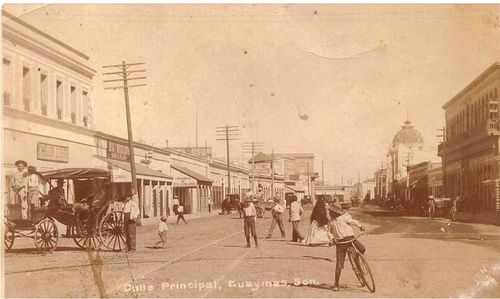
Calle Principal (G. Möller and Co on left)

One of the warehouses (almacenes) of G. Möller and Co.
G. Möller and Co., Sucesores was one of the oldest and most progressive firms in Guaymas, established by Gustavo Möller in 1875 and on his death carried on by Enrique von Guendell, Carlos Busjaeger and Agustín Freese. The company’s warehouses “are as large as the stocks it has of steel, dynamite, and all kinds of tools and machinery for mining and agriculture; clothing, woodwork, seeds, liquors and in general an abundant assortment of groceries and merchandise in general. The building covers a large area of land, with its rooms for the display of merchandise, warehouses and offices on the first floor, with some main employee quarters on the second. G. Moller y Cía, Sucs. represents a large part of the shares of the “Compañía Industrial del Sur Pacifíco, S. S. Fábrica de “Los Angeles” and is also in charge of the management of the same business{footnote}Federico García y Alva, Album-Directorio del Estado de Sonora, 1905-1907, Hermosillo{/footnote}.
So the company sold general merchandise, both at wholesale and retail, and ran a very extensive banking business, issuing drafts and exchanges on New York, San Francisco and Mexico City, and making collections for merchants in Mexico and the United States.
Francisco A. Aguilar, Sucesores was the oldest established house in Guaymas, founded in 1849 by F. A. Aguilar, with its name changed in 1876. The principal members of the firm were Agustín Bustamante and Cayetano L. Yñigo and their wholesale and retail departments and warehouse covered a whole block. They operated an extensive banking business as agents for the Banco Nacional de México and the Banco de Londres, issuing drafts and exchanges on all parts of Mexico, New York and San Francisco, and arranging for collections. In 1899 the Moctezuma Copper Company was drawing its paycheques on this firm. A Mr. Montijo managed the banking department.
Agustín Bustamante was also the general manager of the Compañía Industrial y Explotadora de Maderas and had extensive property and mining interests throughout Sonora.
W. Iberri e Hijos, Sucesores was founded in 1868 by Wenceslao Iberri (Luis Wenceslao Iberri Montijo) and later run by his sons, Ignacio Mario Iberri Rodríguez and Guatimoc Alejandro Iberri Rodríguez. ‘The cash and accounts department was separated from the sales department by a wooden partition with glass panels. There they transacted all their banking business, issuing drafts on New York, San Francisco and various other places’.
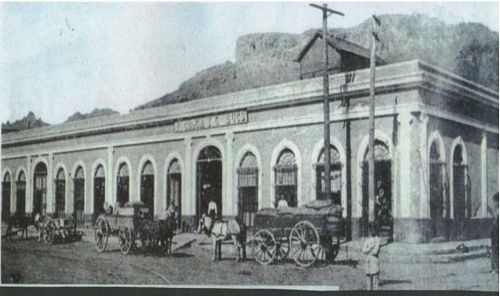 Cosca, Garcia y Cia was established in 1883 by the Spaniards Pedro Cosca{footnote}from Balmaceda, in Vizcaya{/footnote} and José G. García{footnote}The Mexican, Juan Nepomuceno Bringas, joined them in 1890{/footnote}. It had spacious premises on avenida VIII and offered domestic and imported goods for wholesale, embracing everything in the line of merchandise. "A general banking business is transacted, drafts and exchanges being issued on New York, San Francisco, Spain and all parts of Mexico: collections also being made"{footnote}Federico García y Alva, Album-Directorio del Estado de Sonora, Mexico, 1905-1907{/footnote}.
Cosca, Garcia y Cia was established in 1883 by the Spaniards Pedro Cosca{footnote}from Balmaceda, in Vizcaya{/footnote} and José G. García{footnote}The Mexican, Juan Nepomuceno Bringas, joined them in 1890{/footnote}. It had spacious premises on avenida VIII and offered domestic and imported goods for wholesale, embracing everything in the line of merchandise. "A general banking business is transacted, drafts and exchanges being issued on New York, San Francisco, Spain and all parts of Mexico: collections also being made"{footnote}Federico García y Alva, Album-Directorio del Estado de Sonora, Mexico, 1905-1907{/footnote}.